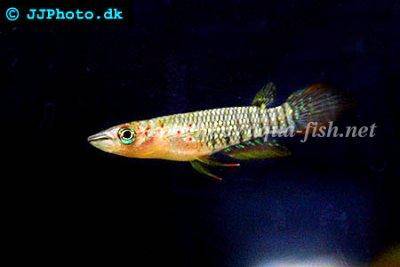Striped panchax - Aplocheilus lineatus
Scientific name: Aplocheilus lineatus
Common name: Striped panchax
Family: Aplocheilidae
Usual size in fish tanks: 10 - 12 cm (3.94 - 4.72 inch)
014
Recommended pH range: 6 - 7.5
Recommended water hardness: 4 - 18°N (71.43 - 321.43ppm)
0°C 32°F30°C 86°F
Recommended temperature range: 24 - 28 °C (75.2 - 82.4°F)
The way how these fish reproduce: Spawning
Where the species comes from: South Asia
Temperament to its own species: peaceful
Temperament toward other fish species: peaceful
Usual place in the tank: Middle levels
Food and Feeding
The Striped Panchax (Aplocheilus lineatus) is a carnivorous species with a natural diet consisting mainly of small insects, larvae, and crustaceans. In the aquarium, they adapt well to a variety of store-bought foods, including high-quality pellets and flakes. To maintain optimal health and coloration, it’s essential to supplement their diet with live or frozen meaty foods such as bloodworms, brine shrimp, and daphnia. Feeding a mix of live and prepared foods a few times a week provides the nutrition they need and encourages natural hunting behaviors.
Sexing
Sexing Striped Panchax is relatively straightforward. Males are typically more colorful, with longer, flowing fins, and they exhibit a sleeker body shape. Their stripes tend to be less prominent compared to females, who are generally more subdued in color and have slightly plumper bodies, especially when ready to spawn. Observing these differences can help identify males and females for breeding purposes or general care.
Breeding
Breeding Striped Panchax in captivity is achievable with the right setup. These fish are egg scatterers and lay buoyant eggs that float among vegetation at the water’s surface. Including floating plants like Salvinia or Water Sprite can encourage natural spawning behavior by providing ideal spawning sites. After spawning, the eggs will hatch within approximately two weeks. Once hatched, the fry can be fed on newly hatched brine shrimp or infusoria. Providing plenty of plant cover or a breeding mop will help protect the eggs and young from potential predation by adult fish.
Lifespan
Unlike some other killifish species that inhabit temporary waters, the Striped Panchax has a relatively long lifespan, often reaching up to 4 years with proper care. As they come from stable environments that do not dry up seasonally, they do not have the short-lived lifecycle typical of many other killifish species. Maintaining good water quality and a balanced diet can help them reach their full lifespan potential.
Origin
The Striped Panchax is native to South Asia, specifically the freshwater rivers, ponds, and slow-moving streams of India and Sri Lanka. In these habitats, they thrive in warm waters with moderate vegetation, often near the water surface where they hunt for small insects and other invertebrates.
Tank Requirements
To replicate their natural habitat, the Striped Panchax requires an aquarium with stable water parameters and a well-covered top, as they are known jumpers. A tank size of at least 40 liters (~10 gallons) is suitable for a small group, though a larger tank will allow them to establish territories and swim freely. The ideal water temperature should be maintained between 24-28°C (75.2-82.4°F), with a pH between 6.0 and 7.5, and moderate hardness (4-18°N).
Aquascaping with floating plants, like Hornwort or Amazon Frogbit, can offer shaded areas and mimic the calm, plant-filled waters they prefer. A gentle filter is recommended to avoid strong currents, as Striped Panchax prefer calm waters and are surface dwellers.
Recommended Tankmates
The peaceful nature of Striped Panchax makes them well-suited to community tanks. Ideal tankmates include:
They do best with other peaceful, similarly sized fish that occupy different levels of the tank. Avoid housing them with large, aggressive species, as Striped Panchax are delicate and may be easily intimidated.
Short Description
The Striped Panchax (Aplocheilus lineatus), also known as the Golden Wonder Killifish, is a popular aquarium species known for its hardiness and surface-feeding behavior. These fish are excellent for beginners due to their adaptability and resilience. They are especially useful in controlling mosquito populations, as they naturally feed on small insects. With their vibrant color patterns and peaceful disposition, Striped Panchax are an attractive addition to community tanks, where they bring both beauty and functionality.
Pictures
Bought by aqua-fish.net from jjphoto.dk.






